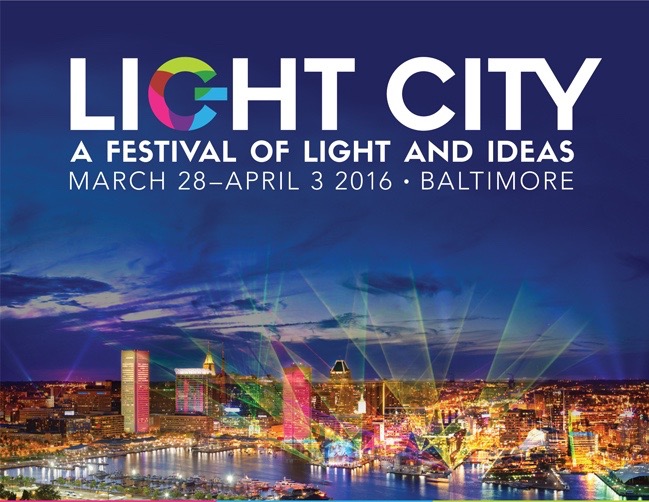
For years, the idea for Light City has been percolating in the minds of Justin Allen and Brooke Hall, creators of What Works Studio. Now, the event dubbed “a festival of light and ideas,” with light installations illuminating the Harbor, musical performances, and innovation sessions has a date—March 28 through April 3, 2016. They’ve joined up with the Baltimore Office of Promotion and the Arts (BOPA) and created a steering committee that includes Jaime McDonald, founder of GiveCorps. There’s even an information session for artists tonight at the Baltimore Museum of Industry about the festival, which roughly 400,000 residents and visitors are projected to attend. We caught up with Allen, Hall, and BOPA executive director Bill Gilmore to discuss what Baltimoreans can expect from Light City.
How did the idea for Light City come about?
Justin: Brooke and I had been thinking about a big event for a long time. We went to a couple events early on that really inspired us. We always felt energized after coming back from festivals or big conferences, and that feeling of being inspired really drove us to consider whether we could do something like this for Baltimore. At the time, we were publishing What Weekly Magazine, which was an attempt to try to shine a light on all the great things happening in the city because we felt like the city was getting a bad rap . . . We realized that there was only so far that we could take that initiative. So we started thinking about how can we put together an event that would have an impact on the city but also showcase the city to the rest of the world for all the amazing things that are happening here.
Brooke: For us, it was just about spotlighting Baltimore as a hub for art and innovation and providing a global stage for the local talent to shine. And to attract some more national and international thought leaders to come and use Baltimore as its lab to build beautiful things and show it to the world.
Justin: I saw these beautiful images of light festivals happening in Australia. Brooke [also] saw them coming across her Facebook feed from a friend of hers who’s a photographer in Australia. At that moment, we were both in separate places seeing all these beautiful images . . . showcasing a city, and it clicked. Light festivals are huge and they’re happening all over the world, not so much in the United States.
Why does light as a thematic element work for Baltimore?
Brooke: Baltimore was the first American city to transform the urban landscape with light. We were the first American city to light its streets with gas lanterns . . . 200 years ago, in 1816. So it was actually kind of synergistic that the years matched up with the 200th anniversary . . . We discovered that early on in our research and were like, “Bingo! This works.” For me, light, especially light art, is at this intersection of art and technology . . . It’s a beautiful way to experiment with both of those fields, and it’s beautiful. Your city is your canvas and you can paint it.
Justin: I think there’s an innate draw of people to light. Especially nowadays with the technology becoming so readily available and affordable you can really create great big spectacles without a lot of resources. The potential to transform the city with light is pretty simple. It’s powerful. You get the opportunity to have both residents and visitors see your city in an entirely different way.
Bill: You can’t live without it. And technology is moving so quickly, this festival has an opportunity to develop new technology in creative ways. It’s not about plugging in and spending a lot of money juicing everything, but new technology—human power, solar power, and other ways of creating light we don’t even know about yet. The call [for entries] is a beast, but we want people to have access to the festival in a variety of ways, whether it’s light, music, innovation . . . We’re going to need a lot of help to make this as great as it can be.
What’s your budget, and what is the breakdown in terms of public vs. private money?
Bill: It’s $4 million, give or take. And it’s all private money, [through fundraising.] It’s a work in progress . . . The other advantage of a BOPA event is that we don’t do anything that isn’t sanctioned by the city. Our first call is to the mayor to see if this is something she’s interested in doing . . . we’re a private, non-profit cultural organization ourselves. We can’t take anything on and commit the city without their full buy-in. There’s a great commitment from the administration to ensure that police, fire, transportation, everything that we need will be available at no cost to the festival.
How much of that budget will go to artists creating the light installations?
Bill: We’ve got several hundred thousand dollars dedicated to the art installations, several hundred thousand dollars for music and performance, several hundred thousand dollars for the innovation component called Light City U . . . it’s very round numbers right now. It’s a big budget . . . We’re about halfway there, with a lot of enthusiasm and commitment from other meetings we’ve had.
What has the response been like from the community?
Justin: Amazing. The [brainstorming session] at the Center for Urban Families was nothing less than inspirational.
Brooke: People, especially at the community sessions, are talking about Light City being the unifying moment for diverse communities around the city, which is really special. It warms my heart to hear other folks say that.
Justin: We’ve always thought about it as the potential to craft one big collaboration every year where people from all over the city get to come and build beautiful things, get to come interact, share ideas, break down those silos that keep us separated all year long. We’re working hard to imagine ways to make that happen. These sessions have been really instrumental in helping us figure that out. I think it was at the first one we had . . . where we got a good bit of pushback . . . [One man] gave us a good bit of criticism, and Jaime looked at him and said, “That’s great, why don’t you join the steering committee? We need more people like you.” I thought that was really powerful thing for her to do.
Did he join?
Justin: He’s been at every meeting.
What can a Baltimore resident expect from the festival?
Justin: The light art and projections are all going to be free, a lot of the music will be free. We haven’t really ironed out how much will be ticketed. Some of the venues downtown, of course, will be ticketed. As for the innovation side . . . we’re going to have some proprietary events that will be ticketed, but we’re hopefully going to be working with local institutions and universities so they can plug into events . . . some of the ticketed events will have scholarships that will be extended to local university and public school students. During the day, there’s going to be a lot of education events going on around the harbor and hopefully city-wide . . . Every night around 7:30, 8 o’clock the lights will come on and it will be a great big beautiful celebration.
So Light City instead of Charm City?
Bill: Let’s see what happens. The best brands are those that are authentic and evolve over the years . . . If Light City does what we anticipate, we will be Light City 365 days a year, not just during the festival . . . To sustain this, it’s going to take a lot of high-level commitment from a lot of people, not just money-wise, but sustaining the momentum and the creativity and the enthusiasm for this . . . that’s going to be more than just a festival, it’s got to be a movement.
